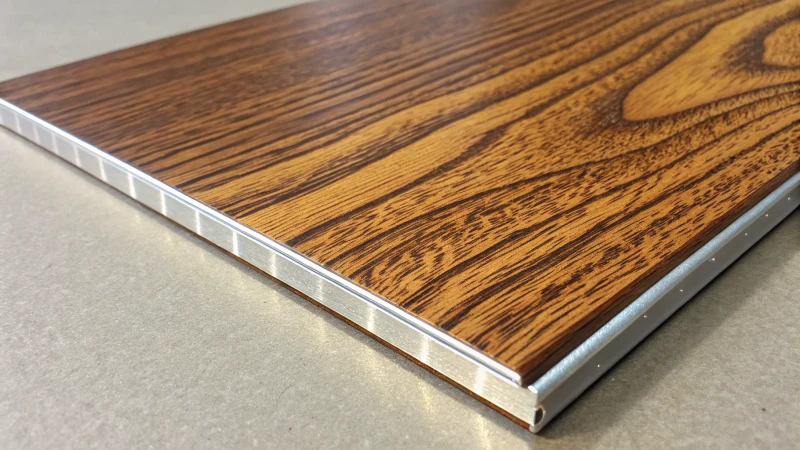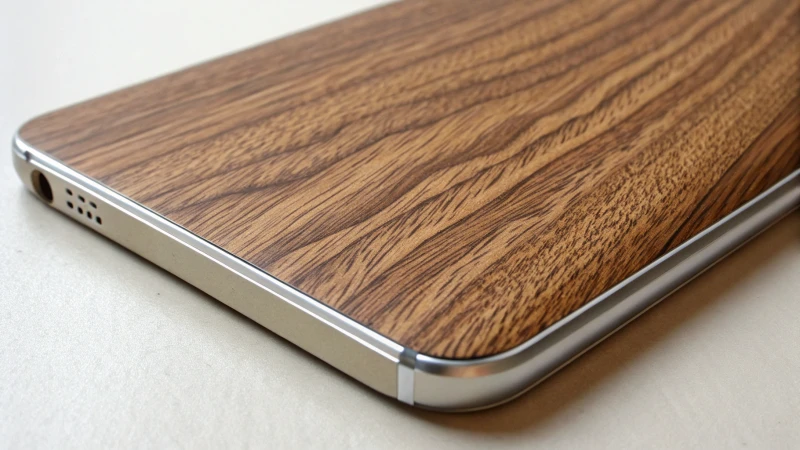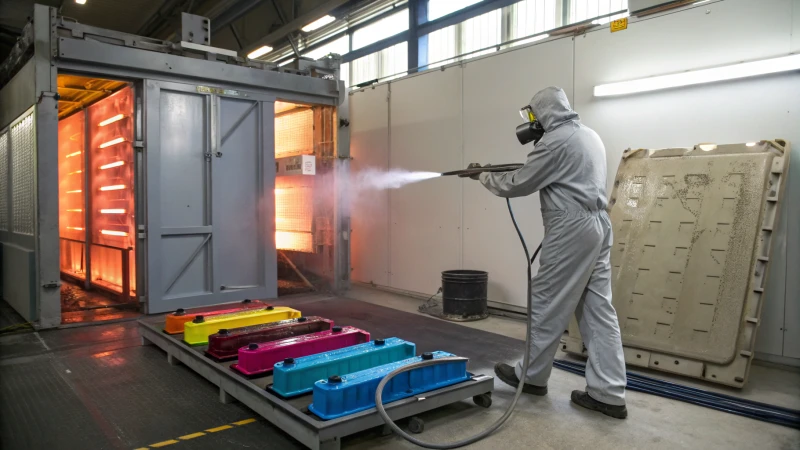How to Achieve High-Quality Wood Grain Finishes on Aluminum?

Achieving a beautiful wood grain finish on aluminum can transform your projects, offering a natural look with robust durability.
To achieve a high-quality wood grain finish on aluminum, select the right alloy like 6063, prepare the surface meticulously, and use advanced techniques such as roller coating or powder coating. Applying a UV protective layer ensures longevity, especially in outdoor settings.
While the initial steps provide the foundation for a quality finish, the following sections will delve into the nuances of each process. From selecting the ideal alloy to mastering application techniques, we’ll guide you through every detail to ensure a flawless result.
Powder coating is essential for wood grain finishes on aluminum.True
Powder coating offers durability and a realistic wood appearance on aluminum.
Using alloy 5052 is best for wood grain finishes on aluminum.False
Alloy 6063, not 5052, is recommended for achieving quality finishes.
What Are the Benefits of Using Aluminum Over Wood?
In the age-old debate of aluminum versus wood, choosing the right material can significantly impact your project’s outcome. Whether you’re crafting furniture, building structures, or designing outdoor equipment, understanding the benefits of aluminum is key.
Aluminum offers superior durability, weather resistance, and low maintenance compared to wood. It’s lightweight, corrosion-resistant, and recyclable, making it an eco-friendly choice for diverse applications.

Durability and Strength
Aluminum is renowned for its exceptional durability and strength, especially in outdoor settings. Unlike wood, which can rot or warp over time, aluminum remains unaffected by moisture. This property makes it ideal for structures exposed to the elements.
Weather Resistance
One significant advantage of aluminum is its resistance to extreme weather conditions. While wood might swell or crack under temperature changes, aluminum maintains its integrity. This feature makes it a preferred material for windows and doors.
Maintenance Requirements
Maintaining wooden structures involves regular treatments to prevent decay and insect damage. Aluminum requires minimal upkeep, saving both time and money. A simple cleaning keeps aluminum looking new.
| Feature | Aluminum | Wood |
|---|---|---|
| Durability | High | Moderate |
| Maintenance | Low | High |
| Environmental Impact | Recyclable | Deforestation concerns |
Environmental Impact
Aluminum is 100% recyclable, reducing the carbon footprint associated with production. In contrast, using wood contributes to deforestation unless sustainably sourced.
Cost-Effectiveness
Although aluminum might have a higher initial cost than some woods, its longevity and low maintenance lead to better cost-effectiveness over time. For large-scale projects, this can mean significant savings.
Aesthetic Versatility
Aluminum’s ability to mimic wood finishes means you can enjoy the natural look of wood without compromising on durability. Techniques such as powder coating allow for various textures and colors, enhancing design flexibility.
Lightweight Nature
The lightweight nature of aluminum makes it easier to handle and install than wood. This characteristic reduces transportation costs and labor efforts during construction.
The choice between aluminum and wood depends on specific project requirements, but understanding these benefits can guide you in making informed decisions that align with your goals.
Aluminum is more durable than wood outdoors.True
Aluminum resists moisture, preventing rot and warping, unlike wood.
Wood requires less maintenance than aluminum.False
Wood needs regular treatments to prevent decay, unlike low-maintenance aluminum.
How Does Alloy Selection Affect Finish Quality?
Choosing the right alloy is crucial in determining the finish quality of products. Different alloys offer varying properties, impacting surface appearance, durability, and overall performance.
Alloy selection significantly influences finish quality by affecting surface smoothness, adhesion properties, and corrosion resistance. Choosing the right alloy, like 6063 aluminum, ensures optimal finish quality for specific applications.

Impact of Surface Smoothness
The surface smoothness of an alloy greatly affects finish quality. Alloys with a fine grain structure provide a smoother surface, which is essential for coatings and finishes. For example, 6063 aluminum is preferred in architectural applications due to its ability to achieve a high-quality finish.
Adhesion Properties and Coating Compatibility
Different alloys have varying adhesion properties, influencing how well a finish adheres to the surface. Alloys with high silicon content often pose challenges in coating adhesion. However, using pre-treatment techniques like anodizing can enhance adhesion for these alloys.
| Alloy Type | Finish Quality | Common Applications |
|---|---|---|
| 6063 Aluminum | High | Architectural Frames |
| 7075 Aluminum | Moderate | Aerospace Components |
| 5052 Aluminum | Good | Marine Equipment |
Corrosion Resistance Impacts
Corrosion resistance is another factor where alloy selection impacts finish quality. Alloys prone to corrosion can lead to finishes that deteriorate quickly. An alloy like 3003 aluminum offers excellent corrosion resistance, making it suitable for outdoor finishes.
Cost vs. Performance Considerations
While selecting an alloy, balancing cost and performance is crucial. Alloys like 2024 aluminum offer superior strength but at a higher cost, impacting the decision based on budget constraints and performance requirements.
Alloy Composition and Surface Treatments
The composition of an alloy dictates its response to surface treatments such as anodizing or electroplating. Understanding the metallurgical composition helps in predicting how an alloy will react to different finishing processes. This knowledge is crucial for industries aiming for consistent finish quality across production batches.
Real-World Examples and Case Studies
Consider the automotive industry, where the choice between steel and aluminum alloys affects not just weight and performance but also the finish quality. Aluminum alloys often require additional surface treatment to match the aesthetic quality provided by steel.
This detailed examination illustrates how different factors related to alloy selection play a pivotal role in achieving desired finish quality across various applications.
6063 aluminum provides a high-quality finish.True
6063 aluminum is preferred for its smooth surface, ideal for finishes.
High silicon alloys have excellent coating adhesion.False
High silicon content can reduce coating adhesion, needing pre-treatment.
Why Is Surface Preparation Crucial for Wood Grain Finishes?
Discover why meticulous surface preparation is the key to unlocking stunning, durable wood grain finishes on any material. Enhance your project’s quality and longevity with these essential insights.
Surface preparation ensures the adhesion of wood grain finishes by removing impurities and creating a smooth base. This step prevents defects, enhances durability, and results in a flawless, realistic appearance.

Understanding the Role of Surface Preparation
Surface preparation is the foundation for achieving premium wood grain finishes. It involves cleaning and smoothing the base material to ensure optimal adhesion of coatings. A well-prepared surface is free from dirt, oils, or oxidation, which could otherwise compromise the finish.
Techniques for Effective Surface Preparation
To prepare surfaces effectively, consider using a combination of techniques. Start with degreasing to remove oils, followed by mechanical abrasion to smooth the surface, and finish with chemical etching for a clean, even layer. Each step serves a purpose in ensuring the finish adheres correctly.
| Technique | Purpose |
|---|---|
| Degreasing | Removes oils and contaminants |
| Mechanical Abrasion | Smoothens surface and removes imperfections |
| Chemical Etching | Cleans and prepares the surface for coating |
Impact of Poor Surface Preparation
Neglecting surface preparation can lead to several issues. An inadequately prepared base may result in uneven coatings, poor adhesion, and premature wear. This not only diminishes aesthetic appeal but also affects the longevity of the finish.
Case Study: Aluminum Profiles
In industries like aluminum profile manufacturing, surface preparation is vital. Using techniques such as those described ensures that wood grain finishes are realistic and long-lasting. Companies often employ advanced tools for quality control to maintain consistency across products.
By focusing on surface preparation, manufacturers can achieve finishes that not only look stunning but also withstand environmental challenges over time. This meticulous approach is essential for both aesthetic and functional excellence in wood grain finishing projects.
Surface preparation prevents finish defects.True
Proper preparation removes impurities, ensuring smooth adhesion and preventing defects.
Skipping surface prep enhances wood grain finish.False
Neglecting preparation leads to poor adhesion, uneven coatings, and reduced durability.
What Are the Most Effective Techniques for Wood Grain Application?
Wood grain application brings a natural, elegant touch to various surfaces, enhancing aesthetic appeal. From furniture to walls, mastering wood grain techniques can transform ordinary objects into artistic pieces.
The most effective wood grain application techniques include faux wood painting, wood graining tools, and heat transfer printing. Each method varies in complexity and result, offering versatility for different projects and materials.

Faux Wood Painting
Faux wood painting is a versatile technique that allows you to mimic the look of wood on any surface. This technique involves using brushes, glazes, and combs to create realistic wood textures. Beginners might find it helpful to start with simple patterns before progressing to more intricate designs.
Materials Needed:
- Paintbrushes
- Glazing medium
- Base and topcoat paint
Steps:
- Apply a base coat and let it dry.
- Mix glaze with topcoat paint.
- Use brushes or combs to create wood grain patterns.
Wood Graining Tools
These specialized tools are designed to create authentic wood grain effects effortlessly. They work by dragging or rolling across painted surfaces, simulating the natural lines found in wood. Wood graining tools are perfect for DIY enthusiasts and professionals alike.
Types of Tools:
- Graining combs
- Wood grain rockers
- Rubber rollers
Technique Tips:
- Use graining combs for fine lines.
- Rockers are ideal for knots and natural patterns.
- Practice on scrap material to master control.
Heat Transfer Printing
This modern method uses heat to transfer a printed wood grain pattern onto a surface. It’s highly efficient for large-scale applications, providing a consistent and durable finish. Ideal for surfaces like metal or plastic, heat transfer printing offers numerous pattern options.
Process Overview:
- Print the desired wood pattern on transfer paper.
- Use a heat press to transfer the pattern onto the target surface.
- Peel away the transfer paper to reveal the design.
Comparing Techniques
| Technique | Best For | Difficulty | Cost |
|---|---|---|---|
| Faux Wood Painting | Customization | Medium | Low |
| Wood Graining Tools | Fast results | Easy | Medium |
| Heat Transfer | Large surfaces | Advanced | High |
Key Considerations:
- Choose the technique based on your project size and material.
- Consider the level of detail required for your design.
- Evaluate cost vs. quality to fit your budget and expectations.
Whether you’re a seasoned professional or a novice DIYer, mastering these wood grain application techniques can elevate your craft and broaden your creative horizons.
Faux wood painting requires a heat press.False
Faux wood painting uses brushes and glazes, not a heat press.
Heat transfer printing is best for large surfaces.True
Heat transfer printing efficiently covers large surfaces with consistent patterns.
How Can UV Coating Enhance the Durability of Your Finish?
UV coating can significantly enhance the durability of finishes by offering protection against environmental wear and tear. Discover how this innovative solution works to maintain the aesthetics and longevity of your materials.
UV coating enhances durability by forming a protective barrier that resists scratches, moisture, and fading. It is ideal for outdoor applications, ensuring finishes remain vibrant and long-lasting.

The Science Behind UV Coating
Ultraviolet (UV) coating involves applying a thin film on the surface of materials, which is then cured using UV light. This process creates a robust protective layer that shields against environmental factors like sunlight and moisture. The use of UV coating technology is particularly beneficial in industries that require high-performance finishes.
Advantages of UV Coating
-
Scratch Resistance: UV coatings significantly improve scratch resistance by hardening the surface. This property is crucial in high-traffic areas or for products frequently handled.
-
Moisture Protection: By sealing the material’s surface, UV coatings prevent moisture ingress. This makes them ideal for outdoor furniture or architectural elements exposed to the elements.
-
Fade Resistance: UV coatings protect against fading caused by sunlight exposure, maintaining the material’s original vibrancy over time.
| Advantages | Details |
|---|---|
| Scratch Resistance | Hardened surface reduces wear and tear |
| Moisture Protection | Seals surface to prevent water damage |
| Fade Resistance | Maintains color vibrancy under sunlight |
Practical Applications
UV coatings are versatile, finding uses across various fields:
- Printing Industry: Enhances the durability and appearance of printed materials, making them more resilient to handling.
- Automotive Sector: Protects vehicle exteriors from scratches and UV damage.
- Wood Finishing: Provides a long-lasting, aesthetic finish for wooden products.
By understanding these applications, you can decide how UV coating might benefit your projects.
Choosing the Right UV Coating
When selecting a UV coating, consider factors like the intended use, environmental exposure, and desired finish type. Consulting with industry experts can provide guidance tailored to your specific needs.
UV coating prevents moisture ingress.True
UV coatings seal surfaces, protecting them from water damage.
UV coating reduces scratch resistance.False
UV coatings enhance scratch resistance by hardening surfaces.
Conclusion
Learn how to achieve high-quality wood grain finishes on aluminum through proper alloy selection, meticulous surface preparation, and advanced application techniques like powder coating and UV protection.


